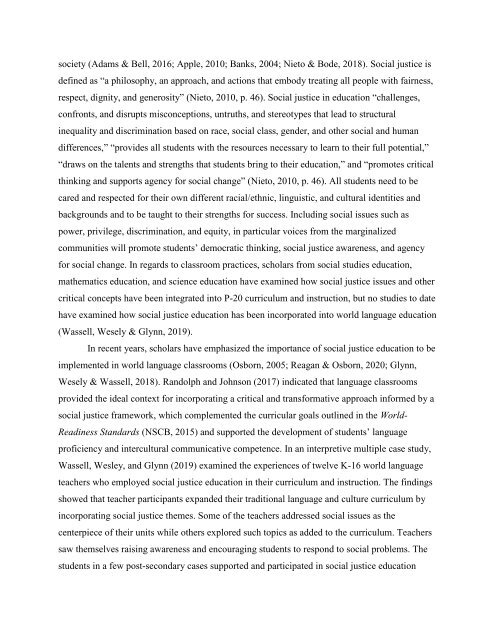K-12 Chinese Language Teaching, Issue 5
The K-12 CLT focuses on sharing experiences and exchanging ideas in teaching, research, and professional development.
The K-12 CLT focuses on sharing experiences and exchanging ideas in teaching, research, and professional development.
You also want an ePaper? Increase the reach of your titles
YUMPU automatically turns print PDFs into web optimized ePapers that Google loves.
society (Adams & Bell, 2016; Apple, 2010; Banks, 2004; Nieto & Bode, 2018). Social justice is<br />
defined as “a philosophy, an approach, and actions that embody treating all people with fairness,<br />
respect, dignity, and generosity” (Nieto, 2010, p. 46). Social justice in education “challenges,<br />
confronts, and disrupts misconceptions, untruths, and stereotypes that lead to structural<br />
inequality and discrimination based on race, social class, gender, and other social and human<br />
differences,” “provides all students with the resources necessary to learn to their full potential,”<br />
“draws on the talents and strengths that students bring to their education,” and “promotes critical<br />
thinking and supports agency for social change” (Nieto, 2010, p. 46). All students need to be<br />
cared and respected for their own different racial/ethnic, linguistic, and cultural identities and<br />
backgrounds and to be taught to their strengths for success. Including social issues such as<br />
power, privilege, discrimination, and equity, in particular voices from the marginalized<br />
communities will promote students’ democratic thinking, social justice awareness, and agency<br />
for social change. In regards to classroom practices, scholars from social studies education,<br />
mathematics education, and science education have examined how social justice issues and other<br />
critical concepts have been integrated into P-20 curriculum and instruction, but no studies to date<br />
have examined how social justice education has been incorporated into world language education<br />
(Wassell, Wesely & Glynn, 2019).<br />
In recent years, scholars have emphasized the importance of social justice education to be<br />
implemented in world language classrooms (Osborn, 2005; Reagan & Osborn, 2020; Glynn,<br />
Wesely & Wassell, 2018). Randolph and Johnson (2017) indicated that language classrooms<br />
provided the ideal context for incorporating a critical and transformative approach informed by a<br />
social justice framework, which complemented the curricular goals outlined in the World-<br />
Readiness Standards (NSCB, 2015) and supported the development of students’ language<br />
proficiency and intercultural communicative competence. In an interpretive multiple case study,<br />
Wassell, Wesley, and Glynn (2019) examined the experiences of twelve K-16 world language<br />
teachers who employed social justice education in their curriculum and instruction. The findings<br />
showed that teacher participants expanded their traditional language and culture curriculum by<br />
incorporating social justice themes. Some of the teachers addressed social issues as the<br />
centerpiece of their units while others explored such topics as added to the curriculum. Teachers<br />
saw themselves raising awareness and encouraging students to respond to social problems. The<br />
students in a few post-secondary cases supported and participated in social justice education


